Review PocketBook 615: the most inexpensive reader with backlight from the market leader
Good day to all! Not so long ago, the official PocketBook blog published a review of the flagship reader PocketBook 631 Touch HD priced at 12,500 rubles. In this model, absolutely all the chips and technologies available today to the manufacturers of readers are collected. However, if your budget categorically disagrees with the figure of “12,500” (and this may well be because time is not easy now), then PocketBook still has options for you. Noticeably more accessible, but, nevertheless, also very good readers in terms of functionality and capabilities. In this post, I’ll tell you about such a middle class model - PocketBook 615. This is the most accessible company with a backlight, it is estimated not to 12,500, but to 8,900 rubles. That is, the device is almost a third cheaper than the flagship of the line of pocketbooks.
Before turning to the review, let me remind you that the official PocketBook blog recently also published posts about the situation on the reader market and about the entire updated line of the company , which was released for sale in early autumn 2016. The line, I recall, consists of six devices. These six devices became the central event in the reader market, perhaps, for the whole of 2016. Is it a joke: not every day the market leader - and in PocketBook the share in Russia is approaching 70% - it releases new models, and it is so massive.
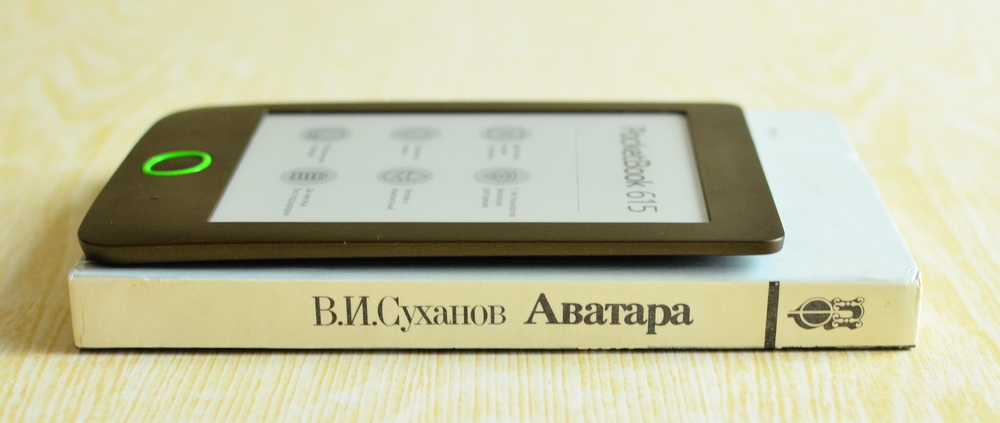
PocketBook 615 is the successor of the popular model PocketBook 614 of 2014 sample. The latter, however, did not disappear from the market, and even received a new version - PocketBook 614 Limited Edition. It has a white body color and cover in the kit. Let's compare these models:
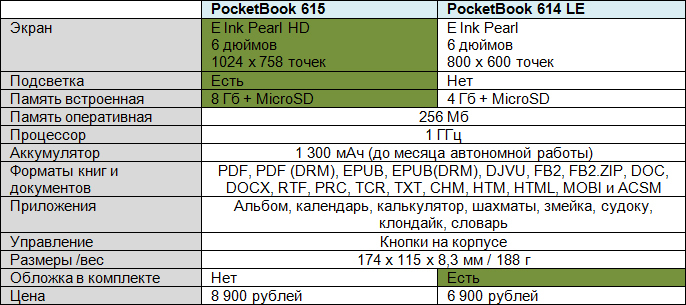
As you can see, PocketBook 615 wins over its remaining predecessor (more precisely, its updated version) screen resolution, the presence of light and a large amount of internal memory. A loses the lack of cover. From myself, I note that the cover is, of course, good, but I really would not call it a necessary thing: the PocketBook 615 is quite unpretentious, and the fragility of the E Ink screens remains in the distant past. So I would take PocketBook 615, even if this model is a bit more expensive. Just the backlight in the reader, in my opinion, is a function of the type "Mast-Hev." And not only at night, but during the day.
The design that we see in PocketBook 615, has been used by PocketBook in other models more than once. I personally do not see anything criminal in such borrowing: over the years, the exterior and ergonomics have been worked out from and to, so that the output is a convenient and reliable device. But then it happens differently: for example, I once switched to the Samsung Galaxy S5 with the Galaxy S4 with difficulty, since the latter was noticeably smaller and more comfortable to use. The same "downgrade" in theory could take place in the case of a poketbook. But no: the design, I repeat, time-tested and more than convenient.


Device control is entrusted to a five-way joystick in the lower part of the front panel of the case - right under the screen. Joystick has a pretty wild green color. What, however, makes the pokebook less boring - and this, in my opinion, is a plus. There are also two separate buttons for page turning. However, you can flip through the pages with the help of a joystick, so there are two options. This is also good: the presence of an alternative in the controls is always pleasing. The third option is not given, since the screen of the PocketBook 615 is non-touch. On the one hand, in this age of sensory interfaces one will have to get used to it, on the other hand, the device is not very expensive. And while backlit. So it's better to have a backlight in the reader than a touchscreen. That is my opinion. And when you consider that the PocketBook 615 interface is designed as that you can reach most of the frequently used items in two or three or four button presses, and you stop grieving about the touchscreen. If you need a reader with a touchscreen, then you can take the PocketBook 625 Touch 2 (inexpensive option) or PocketBook 631 Touch HD (more expensive, but also with a noticeably greater number of possibilities).
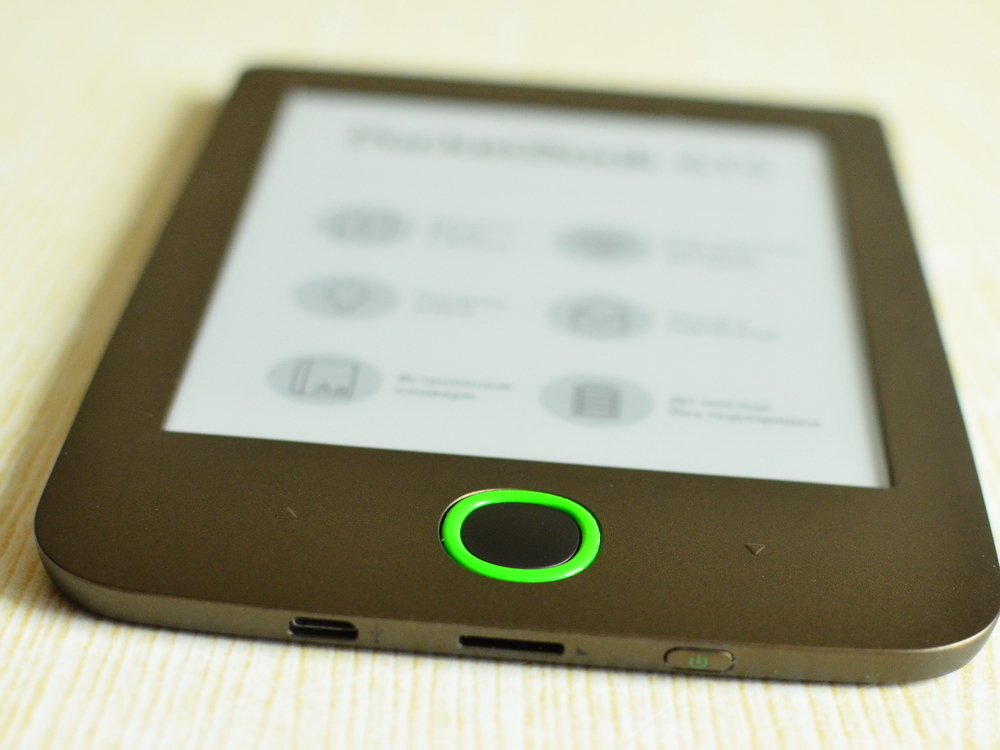
The front panel of the package is made of solid brown plastic, the back one is made of soft-touch. On the surface of the back part there is a protrusion for the finger - index or middle, this is more convenient for anyone. The ledge helps to comfortably hold the pocketbook in your hand. The weight of the model is 188 g, which is not very much for a 6-inch device - some Kindles with the same diagonal weigh over 200 g.

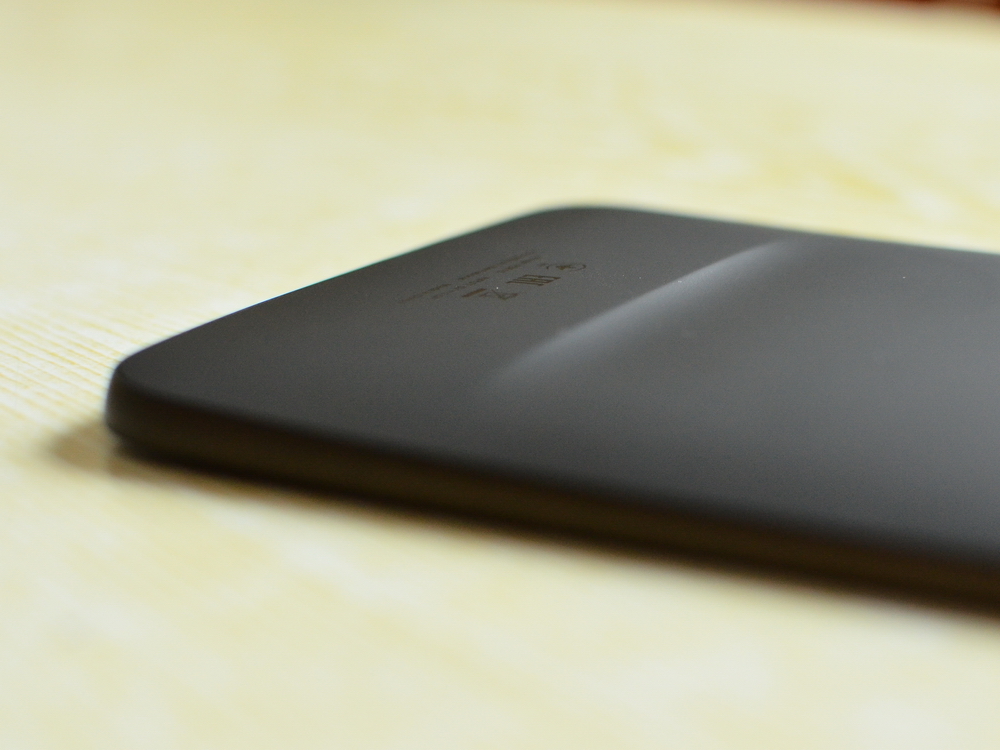
MicroUSB cable connector, microSD card slot and power button located on the bottom of the case. The maximum capacity of the flash drive reaches 32 GB. To put at least some kind of card in PocketBook 615 (I have such cards in any closet in my closet) I sincerely recommend - so that no dust gets into the slot. If this moment does not bother you, then you can do without a flash drive: the built-in memory in the PocketBook 615 is already 8 GB. What, given the inability of this reader to play music, is more than enough.

Since the PocketBook 615 is not among the flagship readers, no one has used the display of the latest generation E Ink Carta in it. The model received the previous generation screen - E Ink Pearl HD with a resolution of 1024 x 768 pixels. This display, however, is also quite good: the difference with the “Map” is minimal. Moreover, the resolution pleases: we could supply a matrix with 800 x 600 pixels. Fortunately, we didn’t save much on the screen in PocketBook, and we have what we have. Namely, a very clear and nice looking picture that in its appearance resembles not a newspaper, but a magazine printed in a good typography. (If you need the Carta screen, I refer again to PocketBook 625 Touch 2 and PocketBook 631 Touch HD.)

The highlight of the program in PocketBook 615, of course, is the backlight - this, let me remind you, is the most inexpensive model of PocketBook with this option. It is uniform and quite bright. Access to the adjustment is carried out in a couple of clicks, so that you won't have to wander around the menu. I note that I have long been accustomed to read with light, even with room lighting - it is so much more comfortable. I turn off the backlight (and, by the way, it can be completely turned off - unlike the Kindle) only on the street where I read extremely rarely. Well, taking this opportunity, I will add that such a side “passive” backlight, which works on the principle of a regular flashlight, does not harm the eyes. In contrast to the active backlighting of LCD screens and their ilk, where it forms an image and shines directly into the eyes because of the display.

It is important to note that the backlight with a brightness level of 30 percent (I tested it on this) does not greatly affect the battery life. PocketBook 615 lasted about three weeks in the "2 - 2.5 hours of reading per day." Without backlight, 6-inch readers usually live a month.
In general, the display of the PocketBook 615 is decent - better than one would expect. I say this because I would not be surprised if there was a screen with a resolution of 800 x 600. It would not have led to a catastrophe, but 1024 x 758 is better: the text is clearer, as are the smaller interface elements.
First and foremost: like any other PocketBook reader, this model supports as many as 18 book and document formats. Namely: PDF, PDF (DRM), EPUB, EPUB (DRM), DJVU, FB2, FB2.ZIP, DOC, DOCX, RTF, PRC, TCR, TXT, CHM, HTM, HTML, MOBI and ACSM. In short, whatever you download to the poketbook - the file will open quickly and without problems. (This is not a Kindle for you with its half-dozen formats.) I will place particular emphasis on the word “fast”: due to the gigahertz processor PocketBook 615 seconds, 5 megabyte PDFs are opened in 5 seconds, which is quite fast.
Text settings are as follows: 13 selectable fonts, hyphens, line spacing, typeface, size, vertical or horizontal orientation of the screen. In general, you can customize the display of books exactly as you specifically want. Of course, it would be more convenient to indulge in all these tweaking in the settings from the touch screen, but using the keys to do this is also realistic.
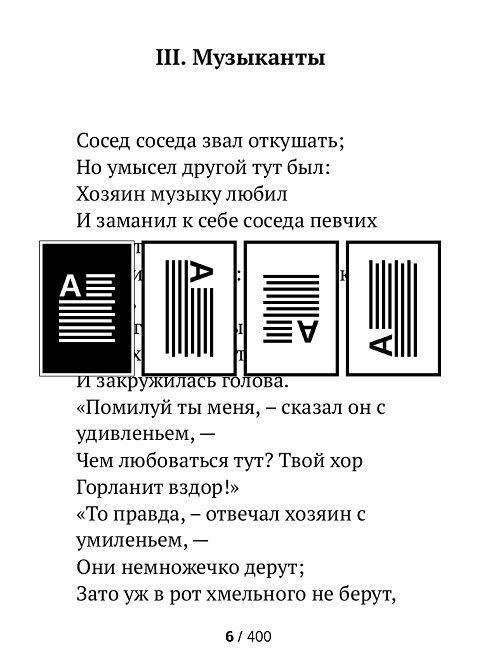


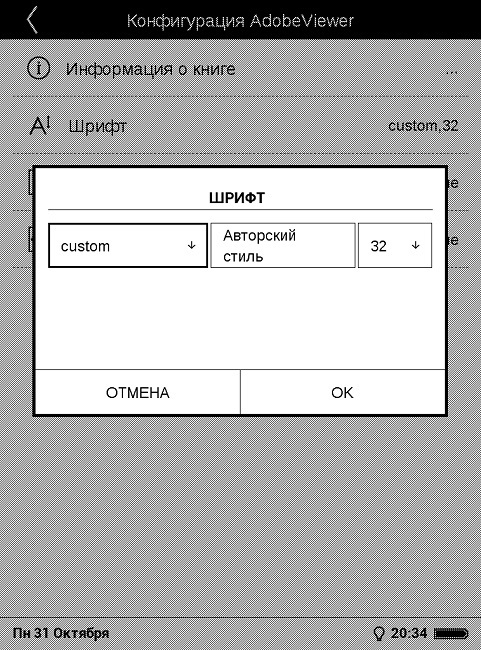
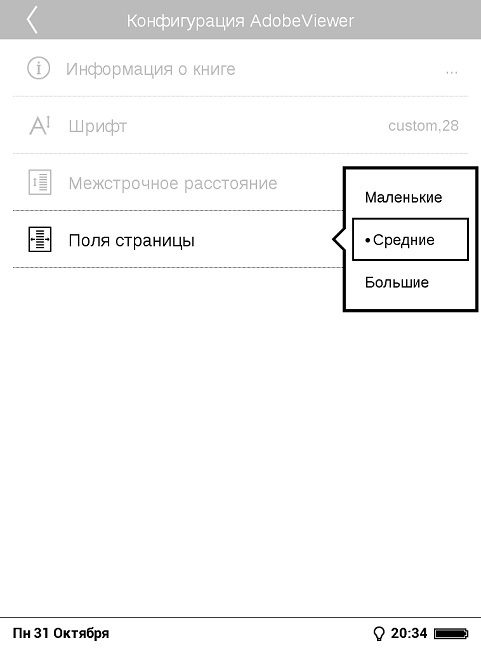
Among other amenities, I note the presence of four dictionaries, they can be called both from the menu and when reading a book, highlighting a specific word and immediately receiving the translation.


The main screen of PocketBook 615 is presented in the form of a page with a list of recently added / open books, as well as four icons: library, notes, applications, settings. You can copy book fragments to notes. The application menu is designed in the same way as in smartphones and tablets, for example, on Android - that is, in the form of a matrix of icons.
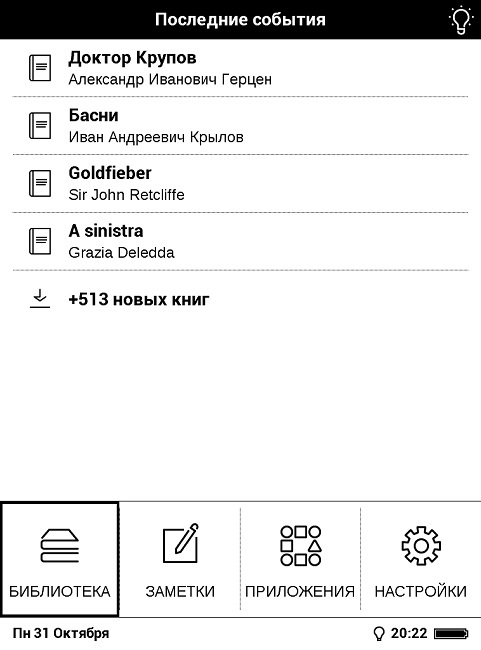

In PocketBook 615 there are several simple games, a calendar, a calculator and a photo album. The latter allows you to view photos, however, only in black and white.
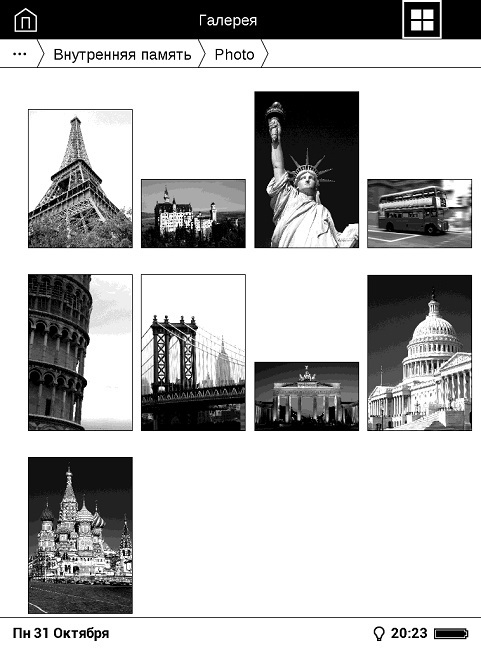
Downloading books to the PocketBook 615 Pocketbook is carried out only by cable (the device is defined as a removable disk), since there is no Wi-Fi support in the model (it’s five, already mentioned PocketBook 625 Touch 2 and PocketBook 631 Touch HD). And with it, and synchronization via Dropbox, and receiving books via e-mail, and PocketBook Sync - that is, the options available to owners of Wi-Fi Pocketbooks.
But in the PocketBook 615 there remained another proprietary "trick" of the PocketBook models - profiles. They allow several people to comfortably use one reader. That is, for example, each family member may have his own liqueurs, and each person can continue to read the book from the point at which he stopped, although before the reader could take another user and read something different. Very convenient!
PocketBook 615 (8 900 rubles), I did not find serious drawbacks. Well, yes, I want “wai-fay” and, as a result, the ability to download books by air, but ... I will say this: if you choose between all these high-tech joys and lighting, then I would prefer the latter (assuming the same prices for a model with Wi- Fi and backlit model). Because the reader - this device is actually mono-functional, read-oriented. The backlight makes this process much more convenient, and Wi-Fi just helps to download books. Which is also great, but not critical. In general, PocketBook 615, in my opinion, is a potential hit. Especially in its budget segment. This is a successful model for those who want to read it and not trying to keep up with all the newfangled chips at once. Well, if you still need Wi-Fi, then it makes sense to look atPocketBook 626 - on the screen and the backlight is the same (with a touchscreen display), as the 615th, but with the support of wireless communication. Well, or on the model PocketBook 625 Touch 2 and PocketBook 631 Touch HD, which I mentioned above many times.
Before turning to the review, let me remind you that the official PocketBook blog recently also published posts about the situation on the reader market and about the entire updated line of the company , which was released for sale in early autumn 2016. The line, I recall, consists of six devices. These six devices became the central event in the reader market, perhaps, for the whole of 2016. Is it a joke: not every day the market leader - and in PocketBook the share in Russia is approaching 70% - it releases new models, and it is so massive.
Position in the line
PocketBook 615 is the successor of the popular model PocketBook 614 of 2014 sample. The latter, however, did not disappear from the market, and even received a new version - PocketBook 614 Limited Edition. It has a white body color and cover in the kit. Let's compare these models:

As you can see, PocketBook 615 wins over its remaining predecessor (more precisely, its updated version) screen resolution, the presence of light and a large amount of internal memory. A loses the lack of cover. From myself, I note that the cover is, of course, good, but I really would not call it a necessary thing: the PocketBook 615 is quite unpretentious, and the fragility of the E Ink screens remains in the distant past. So I would take PocketBook 615, even if this model is a bit more expensive. Just the backlight in the reader, in my opinion, is a function of the type "Mast-Hev." And not only at night, but during the day.
Design and management
The design that we see in PocketBook 615, has been used by PocketBook in other models more than once. I personally do not see anything criminal in such borrowing: over the years, the exterior and ergonomics have been worked out from and to, so that the output is a convenient and reliable device. But then it happens differently: for example, I once switched to the Samsung Galaxy S5 with the Galaxy S4 with difficulty, since the latter was noticeably smaller and more comfortable to use. The same "downgrade" in theory could take place in the case of a poketbook. But no: the design, I repeat, time-tested and more than convenient.
Device control is entrusted to a five-way joystick in the lower part of the front panel of the case - right under the screen. Joystick has a pretty wild green color. What, however, makes the pokebook less boring - and this, in my opinion, is a plus. There are also two separate buttons for page turning. However, you can flip through the pages with the help of a joystick, so there are two options. This is also good: the presence of an alternative in the controls is always pleasing. The third option is not given, since the screen of the PocketBook 615 is non-touch. On the one hand, in this age of sensory interfaces one will have to get used to it, on the other hand, the device is not very expensive. And while backlit. So it's better to have a backlight in the reader than a touchscreen. That is my opinion. And when you consider that the PocketBook 615 interface is designed as that you can reach most of the frequently used items in two or three or four button presses, and you stop grieving about the touchscreen. If you need a reader with a touchscreen, then you can take the PocketBook 625 Touch 2 (inexpensive option) or PocketBook 631 Touch HD (more expensive, but also with a noticeably greater number of possibilities).
The front panel of the package is made of solid brown plastic, the back one is made of soft-touch. On the surface of the back part there is a protrusion for the finger - index or middle, this is more convenient for anyone. The ledge helps to comfortably hold the pocketbook in your hand. The weight of the model is 188 g, which is not very much for a 6-inch device - some Kindles with the same diagonal weigh over 200 g.
MicroUSB cable connector, microSD card slot and power button located on the bottom of the case. The maximum capacity of the flash drive reaches 32 GB. To put at least some kind of card in PocketBook 615 (I have such cards in any closet in my closet) I sincerely recommend - so that no dust gets into the slot. If this moment does not bother you, then you can do without a flash drive: the built-in memory in the PocketBook 615 is already 8 GB. What, given the inability of this reader to play music, is more than enough.
Screen
Since the PocketBook 615 is not among the flagship readers, no one has used the display of the latest generation E Ink Carta in it. The model received the previous generation screen - E Ink Pearl HD with a resolution of 1024 x 768 pixels. This display, however, is also quite good: the difference with the “Map” is minimal. Moreover, the resolution pleases: we could supply a matrix with 800 x 600 pixels. Fortunately, we didn’t save much on the screen in PocketBook, and we have what we have. Namely, a very clear and nice looking picture that in its appearance resembles not a newspaper, but a magazine printed in a good typography. (If you need the Carta screen, I refer again to PocketBook 625 Touch 2 and PocketBook 631 Touch HD.)
The highlight of the program in PocketBook 615, of course, is the backlight - this, let me remind you, is the most inexpensive model of PocketBook with this option. It is uniform and quite bright. Access to the adjustment is carried out in a couple of clicks, so that you won't have to wander around the menu. I note that I have long been accustomed to read with light, even with room lighting - it is so much more comfortable. I turn off the backlight (and, by the way, it can be completely turned off - unlike the Kindle) only on the street where I read extremely rarely. Well, taking this opportunity, I will add that such a side “passive” backlight, which works on the principle of a regular flashlight, does not harm the eyes. In contrast to the active backlighting of LCD screens and their ilk, where it forms an image and shines directly into the eyes because of the display.
It is important to note that the backlight with a brightness level of 30 percent (I tested it on this) does not greatly affect the battery life. PocketBook 615 lasted about three weeks in the "2 - 2.5 hours of reading per day." Without backlight, 6-inch readers usually live a month.
In general, the display of the PocketBook 615 is decent - better than one would expect. I say this because I would not be surprised if there was a screen with a resolution of 800 x 600. It would not have led to a catastrophe, but 1024 x 758 is better: the text is clearer, as are the smaller interface elements.
Software and features
First and foremost: like any other PocketBook reader, this model supports as many as 18 book and document formats. Namely: PDF, PDF (DRM), EPUB, EPUB (DRM), DJVU, FB2, FB2.ZIP, DOC, DOCX, RTF, PRC, TCR, TXT, CHM, HTM, HTML, MOBI and ACSM. In short, whatever you download to the poketbook - the file will open quickly and without problems. (This is not a Kindle for you with its half-dozen formats.) I will place particular emphasis on the word “fast”: due to the gigahertz processor PocketBook 615 seconds, 5 megabyte PDFs are opened in 5 seconds, which is quite fast.
Text settings are as follows: 13 selectable fonts, hyphens, line spacing, typeface, size, vertical or horizontal orientation of the screen. In general, you can customize the display of books exactly as you specifically want. Of course, it would be more convenient to indulge in all these tweaking in the settings from the touch screen, but using the keys to do this is also realistic.





Among other amenities, I note the presence of four dictionaries, they can be called both from the menu and when reading a book, highlighting a specific word and immediately receiving the translation.


The main screen of PocketBook 615 is presented in the form of a page with a list of recently added / open books, as well as four icons: library, notes, applications, settings. You can copy book fragments to notes. The application menu is designed in the same way as in smartphones and tablets, for example, on Android - that is, in the form of a matrix of icons.


In PocketBook 615 there are several simple games, a calendar, a calculator and a photo album. The latter allows you to view photos, however, only in black and white.

Downloading books to the PocketBook 615 Pocketbook is carried out only by cable (the device is defined as a removable disk), since there is no Wi-Fi support in the model (it’s five, already mentioned PocketBook 625 Touch 2 and PocketBook 631 Touch HD). And with it, and synchronization via Dropbox, and receiving books via e-mail, and PocketBook Sync - that is, the options available to owners of Wi-Fi Pocketbooks.
But in the PocketBook 615 there remained another proprietary "trick" of the PocketBook models - profiles. They allow several people to comfortably use one reader. That is, for example, each family member may have his own liqueurs, and each person can continue to read the book from the point at which he stopped, although before the reader could take another user and read something different. Very convenient!
Total
PocketBook 615 (8 900 rubles), I did not find serious drawbacks. Well, yes, I want “wai-fay” and, as a result, the ability to download books by air, but ... I will say this: if you choose between all these high-tech joys and lighting, then I would prefer the latter (assuming the same prices for a model with Wi- Fi and backlit model). Because the reader - this device is actually mono-functional, read-oriented. The backlight makes this process much more convenient, and Wi-Fi just helps to download books. Which is also great, but not critical. In general, PocketBook 615, in my opinion, is a potential hit. Especially in its budget segment. This is a successful model for those who want to read it and not trying to keep up with all the newfangled chips at once. Well, if you still need Wi-Fi, then it makes sense to look atPocketBook 626 - on the screen and the backlight is the same (with a touchscreen display), as the 615th, but with the support of wireless communication. Well, or on the model PocketBook 625 Touch 2 and PocketBook 631 Touch HD, which I mentioned above many times.
